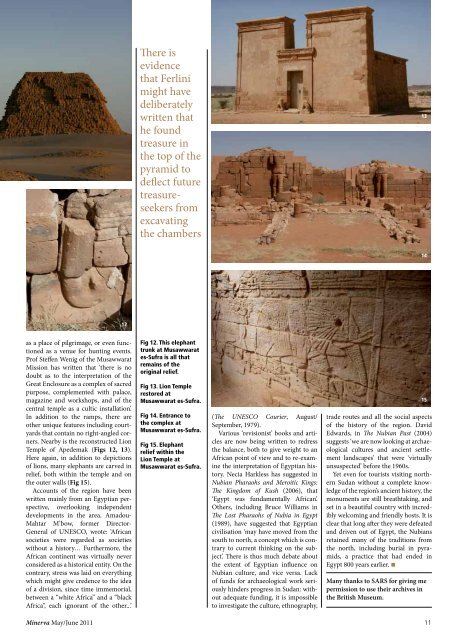Cult of beauty - Minerva
Cult of beauty - Minerva
Cult of beauty - Minerva
You also want an ePaper? Increase the reach of your titles
YUMPU automatically turns print PDFs into web optimized ePapers that Google loves.
12<br />
as a place <strong>of</strong> pilgrimage, or even functioned<br />
as a venue for hunting events.<br />
Pr<strong>of</strong> Steffen Wenig <strong>of</strong> the Musawwarat<br />
Mission has written that ‘there is no<br />
doubt as to the interpretation <strong>of</strong> the<br />
Great Enclosure as a complex <strong>of</strong> sacred<br />
purpose, complemented with palace,<br />
magazine and workshops, and <strong>of</strong> the<br />
central temple as a cultic installation’.<br />
In addition to the ramps, there are<br />
other unique features including courtyards<br />
that contain no right-angled corners.<br />
Nearby is the reconstructed Lion<br />
Temple <strong>of</strong> Apedemak (Figs 12, 13).<br />
Here again, in addition to depictions<br />
<strong>of</strong> lions, many elephants are carved in<br />
relief, both within the temple and on<br />
the outer walls (Fig 15).<br />
Accounts <strong>of</strong> the region have been<br />
written mainly from an Egyptian perspective,<br />
overlooking independent<br />
developments in the area. Amadou-<br />
Mahtar M’bow, former Director-<br />
General <strong>of</strong> UNESCO, wrote: ‘African<br />
societies were regarded as societies<br />
without a history… Furthermore, the<br />
African continent was virtually never<br />
considered as a historical entity. On the<br />
contrary, stress was laid on everything<br />
which might give credence to the idea<br />
<strong>of</strong> a division, since time immemorial,<br />
between a “white Africa” and a “black<br />
Africa”, each ignorant <strong>of</strong> the other...’<br />
There is<br />
evidence<br />
that Ferlini<br />
might have<br />
deliberately<br />
written that<br />
he found<br />
treasure in<br />
the top <strong>of</strong> the<br />
pyramid to<br />
deflect future<br />
treasureseekers<br />
from<br />
excavating<br />
the chambers<br />
Fig 12. This elephant<br />
trunk at Musawwarat<br />
es-Sufra is all that<br />
remains <strong>of</strong> the<br />
original relief.<br />
Fig 13. Lion Temple<br />
restored at<br />
Musawwarat es-Sufra.<br />
Fig 14. Entrance to<br />
the complex at<br />
Musawwarat es-Sufra.<br />
Fig 15. Elephant<br />
relief within the<br />
Lion Temple at<br />
Musawwarat es-Sufra.<br />
(The UNESCO Courier, August/<br />
September, 1979).<br />
Various ‘revisionist’ books and articles<br />
are now being written to redress<br />
the balance, both to give weight to an<br />
African point <strong>of</strong> view and to re-examine<br />
the interpretation <strong>of</strong> Egyptian history.<br />
Necia Harkless has suggested in<br />
Nubian Pharaohs and Meroitic Kings:<br />
The Kingdom <strong>of</strong> Kush (2006), that<br />
‘Egypt was fundamentally African’.<br />
Others, including Bruce Williams in<br />
The Lost Pharaohs <strong>of</strong> Nubia in Egypt<br />
(1989), have suggested that Egyptian<br />
civilisation ‘may have moved from the<br />
south to north, a concept which is contrary<br />
to current thinking on the subject’.<br />
There is thus much debate about<br />
the extent <strong>of</strong> Egyptian influence on<br />
Nubian culture, and vice versa. Lack<br />
<strong>of</strong> funds for archaeological work seriously<br />
hinders progress in Sudan: without<br />
adequate funding, it is impossible<br />
to investigate the culture, ethnography,<br />
trade routes and all the social aspects<br />
<strong>of</strong> the history <strong>of</strong> the region. David<br />
Edwards, in The Nubian Past (2004)<br />
suggests ‘we are now looking at archaeological<br />
cultures and ancient settlement<br />
landscapes’ that were ‘virtually<br />
unsuspected’ before the 1960s.<br />
Yet even for tourists visiting northern<br />
Sudan without a complete knowledge<br />
<strong>of</strong> the region’s ancient history, the<br />
monuments are still breathtaking, and<br />
set in a beautiful country with incredibly<br />
welcoming and friendly hosts. It is<br />
clear that long after they were defeated<br />
and driven out <strong>of</strong> Egypt, the Nubians<br />
retained many <strong>of</strong> the traditions from<br />
the north, including burial in pyramids,<br />
a practice that had ended in<br />
Egypt 800 years earlier. n<br />
Many thanks to SARS for giving me<br />
permission to use their archives in<br />
the British Museum.<br />
<strong>Minerva</strong> May/June 2011 11<br />
13<br />
14<br />
15

















